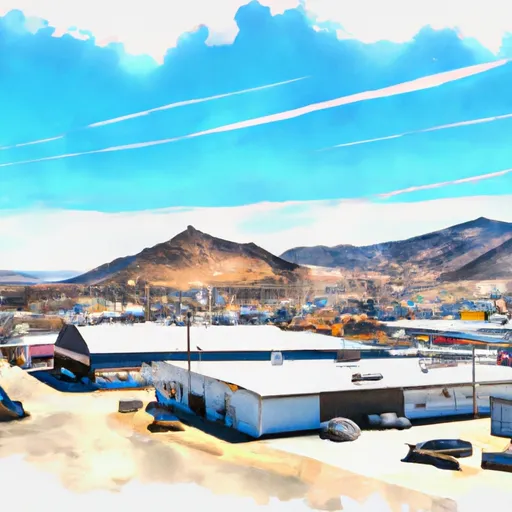-
 Snoflo Premium
Snoflo Premium
Get unlimited access to all our content
With no Ad interruptions! - Start Your Free Trial Login with existing account
Lovelock
Eden Index
Climate
8.4
•
Recreation
1.1
•
Community
1.1
•
Safeguard
4.0/10

Lovelock, Nevada is a small town located in Pershing County, in the western part of the state. With a population of approximately 2,500 people, Lovelock is known for its unique climate, hydrology constituents, and outdoor recreation opportunities.
The climate in Lovelock is classified as a semi-arid desert climate, with hot, dry summers and cold winters. Average temperatures range from the mid-90s Fahrenheit (mid-30s Celsius) in summer to the mid-40s Fahrenheit (around 5 degrees Celsius) in winter. The region receives minimal precipitation, with most rainfall occurring during the winter months.
Lovelock's hydrology is influenced by the Humboldt River, which flows through the area. The river supports diverse wildlife and vegetation, including cottonwoods and willows along its banks. The hydrology constituents also include several reservoirs in the region, offering opportunities for fishing, boating, and water-based recreational activities.
Outdoor recreation in Lovelock is abundant, particularly for nature enthusiasts. The Humboldt Mountains provide opportunities for hiking, camping, and wildlife observation. The nearby Rye Patch State Recreation Area features a reservoir popular for fishing and boating. Hunters can find opportunities for game hunting in the surrounding hills and valleys.
In summary, Lovelock, Nevada offers a unique climate and hydrology constituents that shape its outdoor recreation opportunities. Visitors can enjoy the semi-arid desert climate, explore the Humboldt River, engage in water-based activities, and immerse themselves in the natural beauty of the surrounding mountains and valleys.
What is the Eden Index?
The Snoflo Eden Index serves as a comprehensive rating system for regions, evaluating their desirability through a holistic assessment of climate health, outdoor recreation opportunities, and natural disaster risk, acknowledging the profound impact of these factors on livability and well-being.
Climate Health Indicator (CHI): 8.4
Lovelock receives approximately
159mm of rain per year,
with humidity levels near 78%
and air temperatures averaging around
11°C.
Lovelock has a plant hardyness factor of
6, meaning
plants and agriculture in this region thrive during a short period during spring and early summer. Most
plants will die off during the colder winter months.
By considering the ideal temperature range, reliable water supplies, clean air, and stable seasonal rain or snowpacks, the Climate Health Indicator (CHI) underscores the significance of a healthy climate as the foundation for quality living.
A healthy climate is paramount for ensuring a high quality of life and livability in a region, fostering both physical well-being and environmental harmony. This can be characterized by ideal temperatures, reliable access to water supplies, clean air, and consistent seasonal rain or snowpacks.
Weather Forecast
Streamflow Conditions
Humboldt
Area Rivers
Humboldt
Snowpack Depths
Humboldt
Reservoir Storage Capacity
Humboldt
Groundwater Levels
Recreational Opportunity Index (ROI): 1.1
The Recreational Opportunity Index (ROI) recognizes the value of outdoor recreational options, such as parks, hiking trails, camping sites, and fishing spots, while acknowledging that climate plays a pivotal role in ensuring the comfort and consistency of these experiences.
Access to outdoor recreational opportunities, encompassing activities such as parks, hiking, camping, and fishing, is crucial for overall well-being, and the climate plays a pivotal role in enabling and enhancing these experiences, ensuring that individuals can engage in nature-based activities comfortably and consistently.
Camping Areas
| Campground | Campsites | Reservations | Toilets | Showers | Elevation |
|---|---|---|---|---|---|
| Rye Patch State Park | 45 | 4,149 ft |
Catastrophe Safeguard Index (CSI):
The Catastrophe Safeguard Index (CSI) recognizes that natural disaster risk, encompassing floods, fires, hurricanes, and tornadoes, can drastically affect safety and the overall appeal of an area.
The level of natural disaster risk in a region significantly affects safety and the overall livability, with climate change amplifying these risks by potentially increasing the frequency and intensity of events like floods, fires, hurricanes, and tornadoes, thereby posing substantial challenges to community resilience and well-being.
Community Resilience Indicator (CRI): 1.1
The Community Resilience Indicator (CRI) recognizes that education, healthcare, and socioeconomics are crucial to the well-being of a region. The CRI acknowledges the profound impact of these elements on residents' overall quality of life. By evaluating educational resources, healthcare accessibility, and economic inclusivity, the index captures the essential aspects that contribute to a thriving community, fostering resident satisfaction, equity, and social cohesion.

